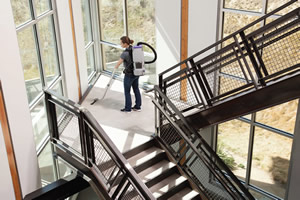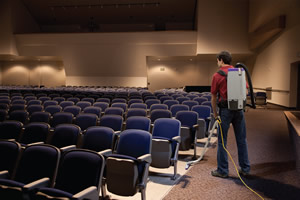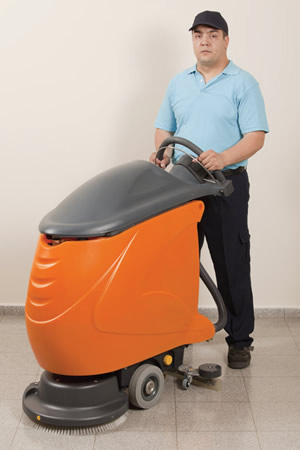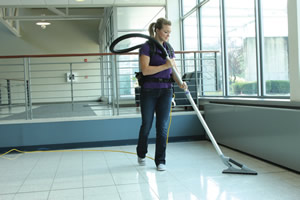Caring for the Cleaning Machine
- By Terry Sambrowski
- 12/01/16

PHOTOS COURTESY OF PROTEAM
Sometimes I wish the administrators
of colleges and universities — along with their cleaning
crews — would purchase professional cleaning equipment
such as vacuum cleaners and floor machines with cash… no credit
cards, no purchase orders, no checks. Perhaps if they paid with cash,
they would have a better understanding of what these machines actually
cost and hopefully treat their equipment a bit more carefully.
Administrators and custodial workers are all aware of cleaning
equipment that has essentially been abused. Even when these
machines are not abused, they often do not receive the preventive
maintenance required to keep cleaning systems such as vacuum
cleaners and floor machines lasting their expected lifespan.
And just what are those expected lifespans?
A commercial upright vacuum cleaner is designed to last at
least three to five years; with abuse or lacking preventive care, the
machine may last less than two years.
Low-speed floor machines (buffers) are very hardy and should
last 10 years or more, depending on how well they are maintained;
automatic scrubbers are much more complicated and delicate machines.
With care and maintenance, automatic scrubbers should
last five to 10 years.
With this in mind, let’s review some ways to keep vacuum
cleaners and autoscrubbers — the two most frequently selected
cleaning machines used in colleges and universities — working
their best, lasting as long as possible, and keeping repair costs in
check.
Buy New, Used or Rent?
Before discussing the care of these machines,
we should address whether campus
administrators or cleaning contractors
should select a new or used or rent a cleaning
machine. With the exception of large
automatic scrubbers and carpet extractors
used for short periods of time, most cleaning
equipment is purchased, not rented. So
the question comes down to this: Is purchasing
a used or rebuilt vacuum cleaner or
floor machine a good option?

PHOTOS COURTESY OF PROTEAM
THE RIGHT TOOLS FOR THE JOB. When investing in vacuum cleaners and other floor machines, it is important to purchase
the best units for the areas of campus in which they will be routinely used. A floor tool that transitions from carpeting to hard
flooring is a must to eliminate time loss from switching tools. An upholstery tool and a dust brush address detail cleaning on
furniture, blinds and architectural details. A crevice tool is one of the most essential tools for hard-to-reach or tight areas where
your technician might otherwise need to move furniture or appliances to reach. In addition to instructing you on the proper care
of the equipment you purchase, the manufacturer can also advise you on the best equipment options for your facilities.
If a contract cleaner has been hired to
clean the college/university than this really
is not an issue if they are members of a
janitorial-related group purchasing organization
(GPO). A GPO member typically
can receive enough of a cost discount from
the manufacturer that it does not warrant
purchasing a used machine.
However, if the service is in-house or your
contractor is not a member of a GPO, the big
thing to consider when purchasing rebuilt
cleaning equipment is “cost of ownership.”
When repair and replacement costs are
figured in, along with downtime for service,
it usually is less costly to select a brand new
vacuum cleaner or floor machine — even if
you must pay full price — from the start.
Caring for Vacuum Cleaners
With this in mind, some of the key ways
to increase the lifespan of vacuum cleaners,
minimize repairs and keep them working
their best include the following:
- No banging or bumping. Avoid banging
or bumping the machine into walls and
furniture. This can damage the base of the
machine, negatively impacting wheels, connections,
components and seals. A vacuum
cleaner “bra” can protect furniture and save
on costly repairs to furniture and walls.
- Check the rotating brush. The rotating
brush is designed to sweep dust and dirt
into the vacuum airflow suction. If the
rotator brush is no longer spinning or
not spinning properly, suction will be
impaired. Remove the brush and clean
it. Inspect the belt to make sure it is not
broken or frayed and remove any debris
collected in the suction area, which might
be impacting airflow and the brush.
- Change filters. One of the best ways to
make sure vacuum cleaner filters are
changed at least twice per year is to time
them to occur with changes in daylight
savings time. Many filters do not even
need to be changed; they just need to be
cleaned. Follow the manufacturer’s instructions
as to how to clean them, allow
them to thoroughly dry, and re-insert.
- Bag inspection. Surprisingly, one of the
most overlooked things is the need to
empty/change the filter bag. Some cleaning
workers do not change the filter bag as
frequently as needed. The more soil the
bag collects, the more suction power will
be reduced. Change the bag when it is half
full, or sooner. This will also help protect a
cloth bag from developing tears or frayed
areas, which could release dust into the air.
- Check the hoses. With an upright
vacuum, the hoses will be enclosed in the
machine. Regularly turn the machine
upside down, open the base, remove the
rotating brush and inspect the openings
that lead into the body of the machine.
Very often if debris is lodged in the hose,
it will be found at these openings. Also,
check the connections of the hose. If pushing
or pulling the hose causes it to move,
there may be a loose connection that can
impair the machine’s performance and
prove harmful to the motor.
- Stay intuitive. When it comes to the
vacuum’s motor, the best thing cleaning
professionals can do to keep the machine
running its best is to pay attention to
the sounds of the motor. Very often,
the sound of the motor will change if
problems are developing. Also, be alert
to smells that occur when the motor is
running — this could be the result of a
badly worn belt or brushes that are stuck
or jammed. While the user can repair
most of the items we have discussed so
far, as soon as there may be an indication
of motor problems, the vacuum should be
inspected by a repairperson.
Caring for Floor Machines
Unlike vacuum cleaners, in which repair and maintenance are
typically quick and easy, floor systems like autoscrubbers may take
more time and be more complicated. And because these machines
are much larger and heavier, simply flipping them over — as we can
with a vacuum cleaner — is almost impossible to do.

PHOTO © CAMBO PHOTOGRAPHY
WHAT’S AN AUTOSCRUBBER? An autoscrubber,
which is short for
automatic scrubber,
is designed to release
cleaning solution onto
the floor, scrub the
cleaning solution into
the floor, and then
vacuum it up all while
the operator is either
pushing the machine or
riding on top of it. For
larger floor areas, this
is an easier, far more
effective and certainly
much faster way to
clean floors.
However, there are things we can do to keep them functioning
properly, reduce repair costs and extend their lifespan. For instance,
the brushes on an autoscrubber can be a magnet for small
debris. Not only can this impact the operation of the machine, it
could also damage floors. If debris is noted, remove it and inspect
all nearby areas to ensure all debris has been removed.
The back squeegee on a floor machine is very important. Its job
is to collect moisture so that the autoscrubber can vacuum it up.
Once again, check for debris collecting on the squeegee. Remove if
found because it can make the squeegee uneven, causing streaks,
and can impair removal of moisture. If the squeegee is developing
rips or tears, it must be replaced.
Most autoscrubbers are now battery-operated. If a traditional
“acid” battery is present, distilled water will need to be added to the
battery. Be careful of the water levels. If the battery is overfilled, acid can leak onto the floor and may cause damage. Newer autoscrubbers
have “gel” batteries; these do not require adding water. In fact, gel
batteries are essentially maintenance-free. Provide adequate ventilation
and never smoke around recharging batteries.
The autoscrubber may also require that joints and connections
be lubricated on a regular basis. However, check with the
owner’s manual as to which joints can be lubricated, using what
type of oil.
Final Thought

PHOTOS COURTESY OF PROTEAM
One of the most important “parts” of a vacuum cleaner or autoscrubber
is the manual that comes with it. So often, the owner’s
manual gets tossed out with the machine’s packaging material…
or is just never reviewed. This is a mistake, because it contains
important information as to how to operate the system properly,
address repairs and perform preventive maintenance on the machine
as and when necessary.
When purchasing a new cleaning machine, campus administrators
and cleaning professionals should take the 20 minutes necessary
to read the manual and study the troubleshooting guide. The troubleshooting
guide is important because this lists possible problem areas
the manufacturer is aware of. It eliminates guessing what’s wrong
with the machine and, because the manufacturer is aware of the issues,
typically lists quick and easy ways to correct problems.
This article originally appeared in the issue of .